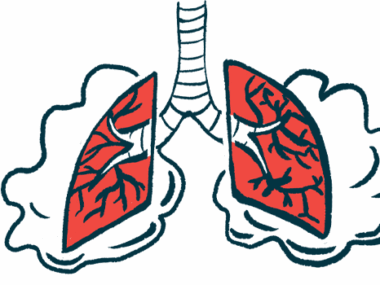Is it normal aging, or is it related to my scleroderma?
Staying aware of my body and the signals it may be giving me is crucial
Written by |

As we get older, how can we tell the difference between the effects of aging and the symptoms and comorbidities related to scleroderma?
When most people think of scleroderma, aging with the disease doesn’t immediately come to mind. When I first read about it in 1974, patients with the disease had far fewer treatment options than they do today. That’s changed, thankfully, and we’re now likely to survive for a longer time.
My diagnosis came when I was a 30-year-old wife and mother. My rheumatologist told me the disease could affect every organ in the body, and she was concerned that my case seemed to be progressing fast. Beyond the physical, it’s not uncommon for people to experience fear and anxiety with any serious illness, and I did.
But over 30 years later, here I am, a senior citizen with scleroderma.
My symptoms and comorbidities
Before I turned 60, I had diabetes and hypertension. I had two heart attacks related to blood flow problems with my heart. I’ve had heart failure, chronic anemia, and both types of lung involvement: interstitial lung disease (ILD) and pulmonary arterial hypertension.
A little shortness of breath, occasional fatigue, and minor aches and pains can be a normal part of getting older. Heart problems and anemia can cause fatigue and shortness of breath, too. But in my case, all of the above were related to my scleroderma. I’m glad I told my doctor about these potential comorbidities and symptoms of scleroderma because lung involvement, in either limited or diffuse forms, is the No. 1 cause of death in scleroderma.
So whoever is managing your scleroderma must know how to diagnose and treat it. They should also know what happens when it isn’t treated.
It was recently confirmed that I have diffuse skin involvement and anti-U1 ribonucleoprotein (U1RNP) antibodies. People with scleroderma and anti-U1RNP antibodies can apparently have symptoms of arthritis and other autoimmune diseases, including myositis, which causes inflammation and pain in the muscles.
Being positive for anti-U1RNP antibodies is also associated with the development of scleroderma-related ILD. That’s why it’s important to listen to your body and keep track of your symptoms over time. That’s especially helpful when you have scleroderma, as serious organ involvement can be associated with its many symptoms.
Staying aware of your body
It’s important to be mindful of the changes you feel over time, as this will help your physician manage your condition. While everyone sometimes feels pain or occasional stiffness with movement as they age, your physician needs to know if these feelings go beyond what you commonly experience.
Another area to observe: How does your physical ability compare with that of others your age? When I was 20, I could do what most people my age could do without much difficulty. I started walking for exercise and then jogging, and then I added some light weight training. In my 30s, I cycled for exercise. In my 40s, I walked. When I was 52, my care provider ordered supplemental oxygen during activity.
But shortness of breath is not the only symptom of scleroderma lung disease; aching muscles can also be a symptom, and a sign that our muscles aren’t getting enough oxygen. Until recently, for instance, I could do elastic band exercises while sitting without much trouble. Now I experience a great deal of pain when doing them. This pain isn’t the soreness of overused muscles; it’s pretty intense. It’s a burning so strong that I had to struggle to complete each repetition; continuing took great effort.
I knew this feeling wasn’t right because it was out of the ordinary for me. Intense pain is a message from our bodies that something is wrong.
One way to stay aware is to keep a journal. Listening to your body and making note of how your symptoms affect your daily routine is a great way to help your physician manage your disease.
Nevertheless, I haven’t been writing in mine for a couple of weeks because my breathing symptoms have been worsening. For a long time, I’ve had problems with chronic fatigue and pain, mainly in my spine and my knees. I used to believe that by determination and willpower alone, I could ignore my symptoms and go about my routine. Many people who are aging seem to have difficulty accepting the changes that come with age — and they may attempt to deny or ignore them. I’ve tried that. But it doesn’t help.
“Turn! Turn! Turn!,” that old song by the Byrds, tells us that there’s a time for everything, and everything in life has a season. Change is a fact of life, but so is adaptation. Rather than fight life’s changes, we should choose to embrace them.
Note: Scleroderma News is strictly a news and information website about the disease. It does not provide medical advice, diagnosis, or treatment. This content is not intended to be a substitute for professional medical advice, diagnosis, or treatment. Always seek the advice of your physician or other qualified health provider with any questions you may have regarding a medical condition. Never disregard professional medical advice or delay in seeking it because of something you have read on this website. The opinions expressed in this column are not those of Scleroderma News or its parent company, Bionews, and are intended to spark discussion about issues pertaining to scleroderma.







Delia
This was a great reminder and very insightful to get feedback from you. Thank you very much
Zeba Hyder
Thank you good article. You have given good advice.
Robert F Combs
Thanks you for this article. I'm somewhat of an anomaly; male, 63, Scleroderma, lupus and fibromyalgia yet I'm still here.
I have these thoughts every time some new cramp, pain or twitching occurs.
Adapting to changes in availability of medications is critical and hardly ever addressed as well. This falls into this catagory. My BP and Gerd meds were both pulled and apparently will never be seen again.
Thanks again, great article and rock onward and forward!
Leonor Y
Thank you for sharing your realistic and uplifting experience and hope for a good life in spite of the challenges those of us with Scleroderma face. The importance of keeping track of any changes and working closely with the doctor is a valuable suggestion that I plan to follow. I also loved the reference to the old song of The Byrds, a season for everything!
Marta Farlin
Tomisa,
I enjoyed reading your article very much. I was diagnosed in 1990, five months after giving birth to my first and only child.During my pregnancy I developed GERD; the skin tightening and darkening began, the lips and nose became thinner and my eyes became rounder. The air hurt my arms. It was in my forearms and below the calf where it was the tightest and a strip inside my inner thighs that felt like twisted pantyhose. Nine years later I was diagnosed with ILD. I was very lucky that my mother who was a nurse noticed it first... She had many patients in the hospital with Scleroderma, but she didn't tell me, she told me I should see my doctor for "swelling." She had already told him what she knew I had. When he saw me he sent me to see an internist who immediately sent me to a Rheumatologist. He put me on high doses of Penicillamine and I lost some hair and all my tastebuds for a while. The medication caused Protein buildup in my blood, so I was off the medication and collecting urine samples for months until the protein was normal range. He took so many vials of blood every week at first, then every two until we got to once a month. I saw him for appointments just as often which eventually became every three months until he retired. I am turning 64 in May and am excited for every year I get older. My pulmonary function tests came back normal for the first time since diagnosed in 1999. I did lose lots of weight though. I have issues with Chronic Anemia, but it runs in my family, so it's hard to guess. I was borderline Pre Diabetes, but that went away about eight years ago. I have Hashimoto's, but it also runs in the family. My GERD is painful when I experience it, but I don't have Barret's Esophagus yet. One of my fingers shortened and my joints are swollen in my hands, but I don't have pain yet. My knees hurt, but when I saw the specialist I was diagnosed with two different things... one for each knee. I have Bursitis in my left knee and Osteoarthritis in my right knee. I struggle with Raynaud's Syndrome, so I have too always carry heated gloves with me. My hair is thinning and I have Macular Degeneration. For some reason, my antibodies for Lupus are high at times.
Your story gives me so much hope. I am sorry about your shortness of breath and the burning in your limbs when exercising. I got that as a child and was told it was lactic acid build up. So far that seems to have been the case. May I ask how old you are because you mentioned reading an article in 1974 about the disease and were diagnosed later. We could be around the same age, but I'm always searching for people older than I am. God Bless you and continue to stay strong and keep what seems to me to be a very positive attitude.
Marta
Shirley M Jauquet
Excellent article! I'm relieved to know I'm not alone in this journey. I was also diagnosed at age 30 with a husband, 2 small children and a challenging IT career. I had to dial back alot during my career, but kept my physicians in the loop always. I was diagnosed with ILD and PAH in the past 3-4 years and have been on supplemental oxygen for 5 years. I'm 62 and wonder often if my aches are due to aging or scleroderma. I started seeing a functional medicine Dr. about 5 years ago (insurance does not cover) and she has been a godsend to addressing my gastrointestinal issues. Keep up the good writing!
Lorrie
Thank you for the article. In it, you mention the management of, the adaption to, and the awareness of your symptoms and adjusting accordingly. As we all are finding ways to live with our diagnosis, it would be so helpful for me to hear of your and other readers' journey with medications, alternative therapies, and emotional and family support experiences. for example, one of the allopathic doctors on my care team suggested hydroxychloroquine and asked me if I was willing to try it. As a natural medicine practitioner, I gave it a try. My experience has been positive. The most noticeable effects are if I am exposed to the common cold or flu and develop symptoms, they never manifest into something acute, and I am over the course within days (as opposed to significantly symptomatic for long periods at a time)
Carol Volckmann
Tomisa, thank you for your post on aging or is it Sclaraderma! Diagnosed nearly 20 years ago and now I am 80 some times, as you say. It is very difficult to know if your aches, pain, fatigue etc is related to Sclaraderma or aging or both.
I also have PAH and various other complications including SIBO, reflux, cirrhosis, enlarged spleen and total incontinence of bowel. I think I gave come to acceptance and just keep going while trying not to focus on what may come next.
I want to thank you agin for your post - a serious reminder in making sure your doctor is aware of any new symptoms and to work with them to see the most productive course of action.
Thank you!
Debra
Thank you. For great articles posted I got diagnosed when 21. Now. 59. I usually get finger ulcers. Have had 1 amputated 2 weeks ago. I got my first ever ulcer on top of 2nd toe. And it's horrific pain worse than on fingers..struggle walking I'm on antibiotics have foot elevated. All. Day...I won't loose faith I Know I'm not alone. I have my lord..n other. Scleoderma warriors
Christel Goetsch
Hello again, Tomisa!
I just sent you another message on a more recent topic…. In reviewing some of your previous posts (which I somehow missed) I found some other things I could relate to.
I believe we may be similar in age. I also wonder if some of my aches, pain, and continued limitations are due to my increasing age or my illness. I do casually mention these to my variety of doctors without sounding kind of ‘crazy’! I tend to ask in a joking manner even though I do want to run my concerns past them and be sure we’re not missing anything new going on. I don’t know if it helps or hinders that I am an ‘old’ nurse with a little more basic medical knowledge.
C.